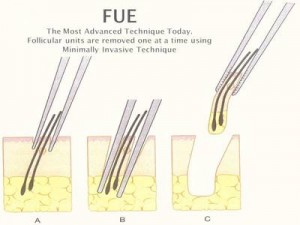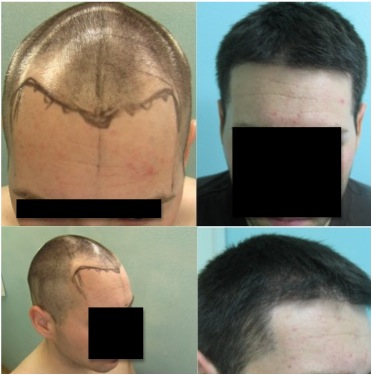THE BASICS: WHAT TO EXPECT DURING A FUE HAIR TRANSPLANT
Hair specialists now use a handheld tool that “punches” each follicular unit in the scalp donor area, with punches only 0.8 to 1.2 millimeters in size in a process called follicular unit extraction. The grafts are then treated and transplanted to the recipient area where there is hair loss. A FUE hair transplant is a less invasive surgery with minimal scarring and faster recovery than follicular unit strip surgery (FUSS), also referred to as strip surgery.
If scarring does occur from a FUE hair transplant, the round holes are not cosmetically visible. Additionally, the technique is more difficult and time consuming to perform. Some hair transplant surgeons do not offer it for those reasons. A FUE hair transplant is also typically more expensive than FUSS.
Advantages Of FUE
- Less invasive surgery
- Minimal recovery time
- Non-visible scarring
- Opportunity to harvest more head donor hair in the future
- Expands donor area

The surgeon begins the extraction process of follicular units using a micropunching tool and needle devices. This is the most time-consuming portion of what to expect during a FUE hair transplant.
PREPARING FOR SURGERY: WHAT TO EXPECT DURING A FUE HAIR TRANSPLANT
During the consultation with a hair transplant surgeon, a patient discusses goals, concerns and the FUE procedure itself. The surgeon also explains what to expect before and after the procedure. The patient is then given detailed preparation instructions for the surgery day.
The day of the FUE hair transplant, the patient should eat a hearty meal. He or she should also arrive to the clinic with a clean, washed scalp. “Before” photos are then taken of the patient upon arrival. Photos give an accurate description of the “starting point” of the surgery and also track hair regrowth process.
DURING SURGERY: WHAT TO EXPECT DURING A FUE HAIR TRANSPLANT
Preparation of the patient begins at the donor area for the FUE hair excision. The patient is given an intramuscular hypnotic to ingest orally, which promotes relaxation. The patient then lies down on an operating table and local anesthesia is administered where hair will be excised. The donor hair, usually the back of the head, is shaved and prepared.
The surgeon begins the extraction process of follicular units using a micro-punching tool and needle devices. This is the most time-consuming portion of the FUE hair surgery. The extracted grafts are then kept in a holding solution until transplanted. When body or facial hair is harvested, the process is similar.
Next the patient is prepped for implantation and sits up. Local anesthesia is administered to the recipient area of hair loss, thinning or balding, which is also typically shaved. The surgeon uses customized blades to create microscopic slits where follicles will be implanted.
AFTER SURGERY: WHAT TO EXPECT DURING A FUE HAIR TRANSPLANT
After the FUE hair transplant, “after” photos are taken. A medical assistant then discusses specific aftercare with the patient. This includes instructions for aspects of daily life such as showering and exercise. The patient also receives topical medication and a prescription for mild painkillers and antibiotics. No stitches or sutures are needed.
Seven days after the FUE hair transplant, remnants of wounding in the donor area should diminish. Within seven to 14 days, scabs in the recipient area usually fall off. “Shedding” is possible for up to eight weeks. Both areas will continue to heal with virtually no scarring.
A patient can expect new hair growth in 14 to 16 weeks, which usually maxes out at a year. New hair will continue to mature and thicken for up to a year and a half after the FUE surgery. Follow-ups with the surgeon will continue during this time to track progress.
Video of Dr U explaining the hair transplant process

